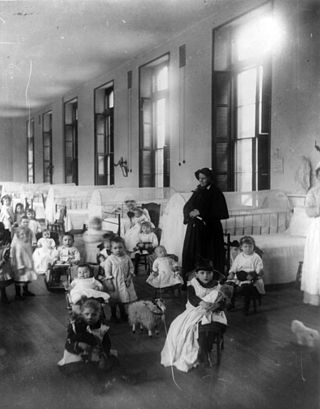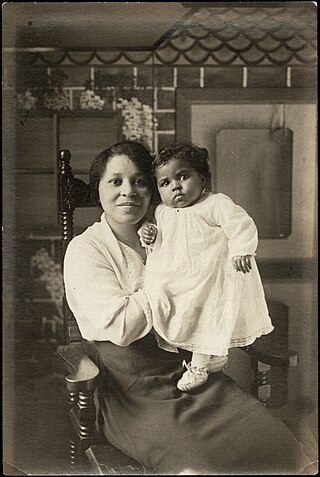Related Research Articles

Adoption is a process whereby a person assumes the parenting of another, usually a child, from that person's biological or legal parent or parents. Legal adoptions permanently transfer all rights and responsibilities, along with filiation, from the biological parents to the adoptive parents.

A mother is the female parent of a child. A woman may be considered a mother by virtue of having given birth, by raising a child who may or may not be her biological offspring, or by supplying her ovum for fertilisation in the case of gestational surrogacy.
The international adoption of South Korean children was at first started as a result of a large number of orphaned mixed children from the Korean War after 1953, but later included orphaned Korean children. Religious organizations in the United States, Australia, and many Western European nations slowly developed into the apparatus that sustained international adoption as a socially integrated system. This system, however, is essentially gone as of 2020. The number of children given for adoption is lower than in comparable OECD countries of a similar size, the majority of adoptees are adopted by South Korean families, and the number of international adoptees is at a historical low.
Closed adoption is a process by which an infant is adopted by another family, and the record of the biological parent(s) is kept sealed. Often, the biological father is not recorded—even on the original birth certificate. An adoption of an older child who already knows their biological parent(s) cannot be made closed or secret. This used to be the most traditional and popular type of adoption, peaking in the decades of the post-World War II Baby Scoop Era. It still exists today, but it exists alongside the practice of open adoption. The sealed records effectively prevent the adoptee and the biological parents from finding, or even knowing anything about each other. However, the emergence of non-profit organizations and private companies to assist individuals with their sealed records has been effective in helping people who want to connect with biological relatives to do so.

More adoptions occur in California each year than any other state. There is domestic adoption, international adoption, step parent adoption and adult adoption.
In the United States, adoption is the process of creating a legal parent–child relationship between a child and a parent who was not automatically recognized as the child's parent at birth.
Open adoption is a form of adoption in which the biological and adoptive families have access to varying degrees of each other's personal information and have an option of contact. While open adoption is a relatively new phenomenon in the west, it has been a traditional practice in many Asian societies, especially in South Asia, for many centuries. In Hindu society, for example, it is relatively common for a childless couple to adopt the second or later son of the husband's brother when the childless couple has limited hope of producing their own child.
The Canadian Council of Natural Mothers (CCNM) is a Canadian lobby group for the rights of women who have placed children for adoption, founded in 1999. It is opposed to most continuing adoption practices, arguing that adoption is traumatic for mothers and frequently does not benefit their children as currently practised. To support mothers, CCNM maintains an active email group which discusses issues which pertain to those who have experienced adoption loss and those who may be in reunion with lost family members. Members of the CCNM also at attend adoption related conferences, government meetings and meetings with social services agencies to educate people about the experiences of natural mothers and argue for improved policies, practices and rights of mothers and adopted people.
Interracial adoption refers to the act of placing a child of one racial or ethnic group with adoptive parents of another racial or ethnic group.
The Minnesota / Texas Adoption Research Project (MTARP) is a longitudinal research study that focuses on the consequences of variations in openness in adoption arrangements for all members of the adoptive kinship network: birthmothers, adoptive parents, and adopted children, and for the relationships within these family systems.
Genealogical bewilderment is a term referring to potential identity problems that could be experienced by a child who was either fostered, adopted, or conceived via an assisted reproductive technology procedure such as surrogacy or gamete donation.
The Baby Scoop Era was a period in anglosphere history starting after the end of World War II and ending in the early 1970s, characterized by an increasing rate of pre-marital pregnancies over the preceding period, along with a higher rate of newborn adoption.
Effects of adoption on the birth mother include stigma and other psychological effects a woman experiences when she places her child for adoption.
The following outline is provided as an overview of and topical guide to adoption:
Concerned United Birthparents, Inc. (CUB), a non-profit organization established in 1976, is one of two primary nationwide organizations offering support to the biological parents of adopted people in the United States. The organization is credited with the creation of the term "birthparent."
LGBT parents in Canada have undergone significant progress in terms of both legal and social acceptance. Same-sex couples who wish for parenthood now enjoy equally the possibilities, responsibilities and rights of opposite-sex couples. Following the nationwide legalization of same-sex marriage in 2005, the number of LGBT families in Canada has increased substantially, paving the way for same-sex couples' aspirations of having their own children. Legal methods of assisted reproduction range from insemination via IVF through to surrogacy arrangements.
Pregnancy options counseling is a form of counseling aimed to counsel women on decision-making for a troubling or unintended pregnancy.
In a confidential birth, the mother provides her identity to authorities, but requires that her identity not be disclosed by the authorities. In many countries, confidential births have been legalized for centuries in order to prevent formerly frequent killings of newborn children, particularly outside of marriage.
Adoption does not exist formally as a practice in Jewish Law (Halacha), although rabbinic texts were not uniform on whether or not they recognized the validity of adoption and several examples of adoption take place in the Hebrew Bible and texts from the Second Temple Judaism. The Hebrew word for adoption ‘אימוץ’ (immutz), which derives from the verb ‘אמץ’ (amatz) in Psalm 80 verse 16 and 18 meaning ‘to make strong’, was not introduced until the modern age. Jewish perspectives towards adoption promote two contradictory messages towards nurture and nature. On the one hand, Judaism expresses favourable attitudes towards adoption across religious movements and is widely viewed as a good deed (mitzvah). Based on the Talmudic teachings that when one raises an orphan in their home, "scripture ascribes it to him as though he had begotten him," Rabbis have argued that the commandment of procreation can also be fulfilled through the act of adoption. However, this interpretation raises a number of questions in relation to lineage and biological status, which is a core value in Halacha.
Adoption in South Korea, specifically the low rates of domestic adoption in their history, has been a point of discussion for the country, causing new policies to be passed over the years. South Korea, at the conclusion of the Korean War in 1953, began to partake in transnational adoption. As these overseas adoptions increased over the next couple of decades, South Korea pushed to encourage fewer transnational adoptions and more domestic adoptions. The high number of children put up for adoption each year in South Korea can be attributed to a variety of factors: the lack of support for unwed mothers, as well as social stigma, contributed greatly to these numbers. Several organizations have been created to support unwed mothers and combat stigma. There has been changes to adoption policies throughout the decades as well. The Special Adoption Act was passed in 2011 with the intention of boosting domestic adoptions. However, the unexpected outcome of more abandoned children ensued following the amendment taking effect.
References
- ↑ Birthparent Legacy Term Archived 2010-12-19 at the Wayback Machine TRIADOPTION® Archives
- ↑ Birth Parents The Adoption History Project
- ↑ Adoption Terminology Child Welfare League of American 1980s
- ↑ Adoption Language Archived 2011-04-26 at the Wayback Machine by Brenda Romanchik
- ↑ Speaking Positively: Using Respectful Adoption Language Archived 2008-06-24 at the Wayback Machine , by Patricia Irwin Johnston
- ↑ PAL 1992 Archived 2011-01-12 at the Wayback Machine OURS 1992
- ↑ Holt 1997 Holt International 1997
- ↑ Logan, J. (1996). "Birth Mothers and Their Mental Health: Uncharted Territory", British Journal of Social Work, 26, 609-625.
- ↑ Wells, S. (1993). "What do Birthmothers Want?", Adoption and Fostering , 17(4), 22-26.
- ↑ "Why Birthmother Means Breeder," Archived 2008-07-06 at the Wayback Machine by Diane Turski
- ↑ [ permanent dead link ]
- ↑ Not By Choice, by Karen Wilson-Buterbaugh, Eclectica, 6(1), Jul/Aug 2001
- ↑ "The Trauma of Relinquishment, Archived 2009-02-16 at the Wayback Machine " by Judy Kelly (1999)
- ↑ Cultural Sensitivity and Political Correctness: The Linguistic Problem of Naming, Edna Andrews, American Speech, Vol. 71, No. 4 (Winter, 1996), pp.389-404.